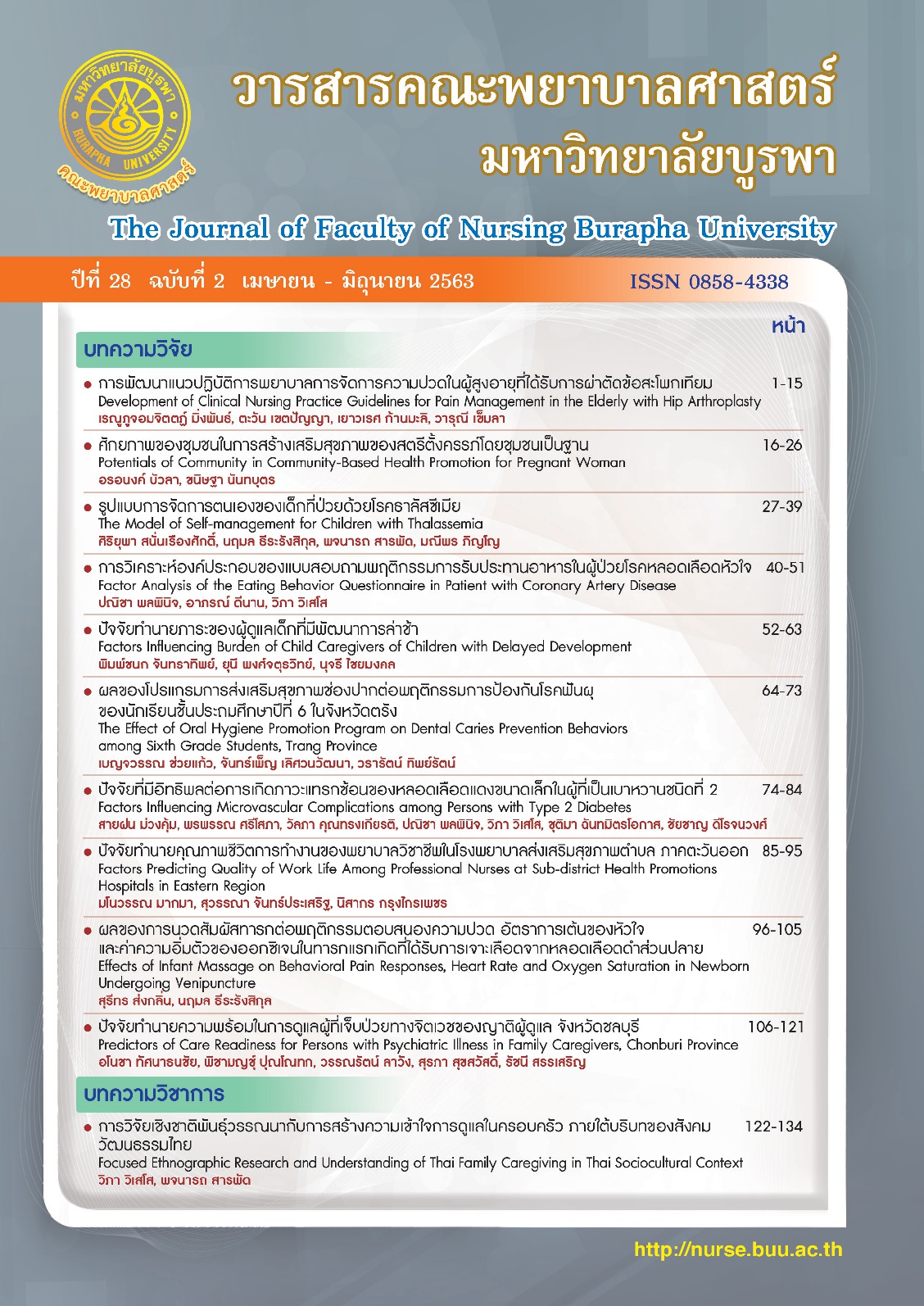การวิเคราะห์องค์ประกอบของแบบสอบถามพฤติกรรม การรับประทานอาหารในผู้ป่วยโรคหลอดเลือดหัวใจ
คำสำคัญ:
โรคหลอดเลือดหัวใจ, พฤติกรรมการรับประทานอาหาร, การวิเคราะห์องค์ประกอบ, ความเชื่อมั่นแบบสอดคล้อง ภายในบทคัดย่อ
การวิจัยในครั้งนี้มีวัตถุประสงค์เพื่อวิเคราะห์องค์ประกอบของแบบสอบถามพฤติกรรมการรับประทานอาหารใน
ผู้ป่วยโรคหลอดเลือดหัวใจ โดยการวิเคราะห์จากข้อมูลทุติยภูมิของการใช้แบบสอบถามพฤติกรรมการรับประทานอาหาร
กลุ่มตัวอย่างเป็นผู้ที่ได้รับการวินิจฉัยว่าเป็นโรคหลอดเลือดหัวใจ จำนวน 268 ราย ที่มารับการรักษา ณ แผนกผู้ป่วยนอก
โรคหัวใจของโรงพยาบาลระดับทุติยภูมิในภาคตะวันออกจำนวน 2 แห่ง วิเคราะห์ข้อมูลโดยการวิเคราะห์องค์ประกอบ
เชิงสำรวจด้วยวีธีการวิเคราะห์องค์ประกอบหลัก และสกัดองค์ประกอบด้วยการหมุนแกนแบบออโธโกนอลด้วยวิธี
แวริแมกซ์ และวิเคราะห์ความเชื่อมั่นแบบสอดคล้องภายในด้วยการคำนวณค่าสัมประสิทธิ์แอลฟ่าครอนบาค
ผลการศึกษาครั้งนี้มีค่า KMO เท่ากับ .86 และค่า MSA ของแบบสอบถามรายข้ออยู่ระหว่าง .604 - .908
ผล Bartlett’s test of Sphericity มีนัยสำคัญทางสถิติ (p < .001) และพบว่าแบบสอบถามการรับประทานอาหารมี
องค์ประกอบหลัก 2 ด้าน คือ ด้านการรับประทานอาหารที่ไม่เหมาะสมต่อสุขภาพ มีข้อคำถามจำนวน 11 ข้อ ซึ่งมี
ค่าน้ำหนักองค์ประกอบระหว่าง .42 - .76 ส่วนด้านการรับประทานอาหารที่มีผลดีต่อสุขภาพ มีข้อคำถามจำนวน 6 ข้อ
และมีค่าน้ำหนักองค์ประกอบ ระหว่าง .42 - .85 โดยทั้งสององค์ประกอบสามารถอธิบายความแปรปรวนร่วมกันได้
ร้อยละ 47.50 ผลการตรวจสอบความเชื่อมั่นแบบสอดคล้องภายในมีค่าสัมประสิทธิ์แอลฟ่าครอนบาค ของแบบสอบถาม
ทั้งฉบับเท่ากับ .87 และรายด้านเท่ากับ .72 และ .76 ตามลำดับ จากการศึกษาครั้งนี้แสดงให้เห็นว่า แบบสอบถามนี้
สามารถนำไปใช้ในการศึกษาหรือประเมินพฤติกรรมการรับประทานอาหารในผู้ป่วยโรคหลอดเลือดหัวใจและในบริบท
ของสังคมไทย
เอกสารอ้างอิง
instruments of eating behaviors: Systematic
revies. APHEIT Journals, 5(2), 56-69 [In Thai]
Beavers, A.S., Lounsbury, J.W., Richards, J.K., Huck,
S.W., Skolits, G.J., & Esquivel, S.L. (2013).
Practical considerations for using
exploratory factor analysis in educational
research. Practical Assessment, Research
& Evaluation, 18(6), 1-12.
Costello, A.B., & Osborne, J.W. (2005). Best
practices in exploratory factor analysis:
Four recommendations for getting the most
from your analysis. Practical Assessment,
Research & Evaluation, 10(7), 1-12.
Deenan, A., & Thanee, S. (2005). Factors related
to readmission of myocardial infarction
patients. Chonburi: Burapha University
[In Thai]
Deenan, A., Rattanagreetakul, S., Thanee, S.,
Sumonwong, W., & Wattanakul, C. (2014).
Risk reduction and quality of life
improvement for people with myocardial
infarction (Phase II). Chonburi: Burapha
University [In Thai]
DeVellis, R.F. (2012). Scale development: Theory
and application. (3rd ed.). Chapel Hill: SAGE
Publications, Inc.
Garson, D.G. (2008). Factor analysis. Retrieved from
http://www.chass.ncsu.sdu/www.snrs.org
Hair, J.F., Black, W.C., Babin, B.J., & Anderson, R.E.
(2010). Multivariate data analysis: A global
perspective (7th ed.). Upper Saddle River,
NJ: Pearson Education.
Health Systems Research Institute. (2014). The 5th
Thai health survey by physical exam 2014.
Search from http://kb.hsri.or.th/dspace/
handle/11228/4626. Accessed on 16 April
2020. [In Thai]
Jirojanakul, P., Nipathatong, S., Keinwong, T.,
Pipatsombat, P., & Rowsathein, N. (2013).
Cardiovascular risk factors in cross-sectional
study. Thai Journal of Cardio-Thoracic
Nursing, 24(1), 44-55. [In Thai]
Munro, B.H. (2005). Statistics methods for health
care research (5th ed.). Philadelphia:
Lippincott Williams & Wilkins
Nangyaem, A. (2007). Determinants of eating
behavior of hypertensive patient. Master
of Nursing Science Program in Adult Nursing,
Graduate school Burapha University.
[In Thai]
Peterson, R.A. (2000). A meta-analysis of variance
accounted for and factor loadings in
exploratory factor analysis. Marketing
Letter, 11(3), 261-275.
Piepoli, M., Corra, U., Adamopoulos, S., Benzer,
W., Bjarnason-Wehrens, B., Cupples, M., …
Giannuzzi, P. (2014). Secondary prevention
in the clinical management of patients with
cardiovascular disease. European Journal
of Preventive Cardiology, 21(6), 664-681.
Polit, D.F. & Beck, C.T. (2017). Nursing research:
Generating and assessing evidence for
nursing practice (10th eds). Philadelphia:
Wolters & Kluwer.
Ponpinij, P. (2017). The effects of nurse-led
cardiac rehabilitation program on health
behaviors and health status in post acute
coronary syndrome person: A randomized
controlled trial. The doctoral degree of
philosophy in nursing science the faculty
of nursing Burapha University.
Saengsiri, A., Wattradul, D., Kangchanakul, S.,
Nutthumrongkul, S., Nopplub, S., &
Wonganunnont, S. (2015). The factors
influencing the self-care agency and
quality of life of patients with coronary
artery disease. Thai Journal of CardioThoracic Nursing, 26(1), 104-118. [In Thai]
Song, R., Oh, H., Ahn, S., & Moorehead, S. (2018).
Validation of cardiac health behavior scale
for Korean adults with cardiovascular risks
or diseases. Applied Nursing Research, 39,
252-258.
trategy and Planning Division, Office of the
Permanent Secretary. (2017). Public health
statistics. Search from http://bps.moph.
go.th/new_bps/sites/default/files/stratistics
60.pdf. Accessed on 16 April 2020. [In Thai]
Tabachnick, B.G., Fidell, L.S. (2007). Using
multivariate statistics (4th ed.). Boston, MA:
Pearson Education.
Theerapunchareon, N. (2019). The risk for
cardiovascular disease among personnel in
Pranakhon Si Aytthaya Rajabhat University.
Journal of Health Science, 28, 137-145.
[In Thai]
Tiansawad, S. (2019). Instrument development
for nursing research. Chiang Mai: Siampim
nana. [In Thai]
Turk-Adawi, K., & Grace, S. (2015). Narrative review
comparing the benefits of participation
cardiac rehabilitation in high-, middle- and
low-income countries. Heart, Lung &
Circulation, 24, 510-520. doi: 10.1016/j.hlc.
201411.2013 [In Thai]
Vanichbuncha, K. (2019). Advanced statistical
analysis with SPSS for Windows (14th ed.).
Bangkok: Chulalongkorn University Printing
House. [In Thai]
Wichitthongchai, C. (2012). The factors associated
with food consumption behaviors of
cardiac and arterial diseases patients in
Queen Sirikit Heart center of the
northeastern region Khonkean University.
Srinagarind Medical Journal, 27(4), 340-346.
Woodruffe, S., Neubeck, L., Clark, R.A., Gray, K.,
Ferry, C., Finan, J., Sanderson, S., … Briffa,
T.G. (2015). Australian cardiovascular health
and rehabilitation association [ACRA] core
components of cardiovascular disease
secondary prevention and cardiac
rehabilitation 2014. Heart, Lung &
Circulation, 24(5), 430-41.





